
Services
返回Testing Services
- Internet of Things authenticat
- UWB Product Certification
- 5G NR Product Certification
- Receiver Product Certification
- SAR testing
- Base station certification
- Interphone product certificati
- Wireless charging product cert
- WiFi Product Certification
- FM/AM Product Certification
- Bluetooth BQB Product Certific
- Mobile communication product c
- Wireless and communication det
- Automotive Electronic Testing
- EMI Test - Conducted Emissions
- EMI Test - Radiation Emission
- EMI testing - low-frequency ma
- EMI Testing - Transient Conduc
- EMS test - low-frequency magne
- EMS Test - High Current Inject
- EMS Testing - Portable Transmi
- EMS Test - Transient Conducted
- EMS Testing - Electrostatic Di
- EMS testing - radiation anti-i
- Electrical performance testing
- Voltage flicker test - Suzhou
- Electrical Fast Pulse Withstan
- Electromagnetic Radiation Tole
- Conducted Immunity Test (CS) -
- Conducted Interference (CE) -
- Common issues with high and lo
- Common issues with fatigue tes
- Common issues with vibration t
- Vibration
- Rapid temperature change test
- Performance testing of automot
- Automotive metal material test
- Comprehensive vibration test o
- Three comprehensive vibration
- Three comprehensive vibration
- Spoiler Three Comprehensive Vi
- Sunvisor Three Comprehensive V
- Comprehensive vibration test o
- Instrument panel/instrument pa
- Temperature shock/cold and hot
- Vibration testing
- Temperature shock test
- Reliability testing
- Automotive ELV&VOC
- Hazardous substance testing
- Testing of toys and baby produ
- Food contact material testing
- Leather Footwear Inspection
- Ecological textile testing
- Consumer Product Testing Servi
- Consumer Product Testing Servi
- Consumer Product Testing Servi
- Consumer Product Testing Servi
- Consumer Product Testing Servi
- Consumer Product Testing Servi
- Consumer Product Testing Servi
- Consumer Product Testing Servi
- Consumer Product Testing Servi
- Automotive ELV&VOC
- Reliability testing
- Climatic Environmental Testing
- Climatic Environmental Testing
- Climate environment testing -
- Climatic environmental testing
- Climate environment testing -
- Climatic environment test - co
- Climatic Environmental Testing
- Climatic Environmental Testing
- Climatic environment testing -
- Climate Environmental Testing
- Climatic environment testing -
- Climate environment testing -
- Mechanical testing - Vibration
- Mechanical testing - Three com
- Mechanical inspection - mechan
- Mechanical testing - Drop test
- Mechanical testing - Packaging
- Other tests - Voltage withstan
- Other tests - Drum drop test
- Other tests - tensile testing
- Other tests - Drum drop test
- Other tests - Paper tape wear
- Other tests -100 grid test
- Other tests - Alcohol abrasion
- Other tests - pencil hardness
Certification Services
Register for the record
Systems and Training Services
Laboratory design and construction
Contact Us


National 24-hour service hotline
86+13560405821
Group Headquarters
E-mail: Lymay.zhong@lcs-cert.com
Address: Juji Industrial Park, Xueziwei, Ngabian, Shajing Street, Baoan District, Shenzhen Building A 1~2F, Building C 3F
Hazardous substance testing
Product range:
RoHS detection
overview
RoHS is a mandatory standard developed by EU legislation, and its full name is the Directive on the Restriction of the Use of Certain Hazardous Substances in Electrical and Electronic Equipment. This standard has been officially implemented on July 2006, 7, mainly used to standardize the material and process standards of electronic and electrical products, making them more conducive to human health and environmental protection. The purpose of the standard is to eliminate lead, mercury, cadmium, hexavalent chromium, polybrominated biphenyls and polybrominated diphenyl ethers from electrical and electronic products, adding 1 phthalates for a total of 4 substances.
Standards and regulatory requirements
EU Regulation/Directive: 2015/863 (EU)
2015/863/EU Hazardous substances and limit requirements: The maximum allowable concentration of hazardous substances in homogeneous materials is:
Restricted substances | Maximum allowable concentration |
lead | 0.1 % |
mercury | 0.1 % |
cadmium | 0.01 % |
Hexavalent chromium | 0.1 % |
Polybrominated biphenyls | 0.1 % |
Polybrominated diphenyl ethers | 0.1 % |
Di(2-ethylhexyl) phthalate | 0,1 % |
Tolylbutyl phthalate | 0.1 % |
Dibutyl phthalate | 0.1 % |
Diisobutyl phthalate | 0.1 % |
RoHS2.0
RoHS 2.0 (2011/65/EU) came into force on July 2011, 7 and came into force on January 21, 2013 (repealed on the same day as 1/3/EC), RoHS 2002.95 expands the product range to eleven categories on the basis of the original RoHS Directive, requiring member states to ensure that EEE and components including their repair parts or reuse or cables or upgrading their functions/capacity comply with the new directive. RoHS 2.0 gives a clear definition of homogeneous materials, stipulating the respective responsibilities and obligations of manufacturers, authorized representatives, importers, sellers, etc.; During the production process, the manufacturer must draw up the necessary technical documentation, carry out internal production control procedures in accordance with Model A specified in Annex II of Decision No. 2/0/EC, and provide a declaration of conformity before the CE mark can be affixed to the final product.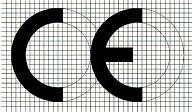
At the same time, manufacturers are required to keep relevant technical documents after the product is placed on the market, and the declaration of conformity is 768 years. The Directive covers 2008 exemptions and is constantly updated.
China RoHS
The Administrative Measures for the Control of Pollution of Electronic Information Products (Implementation Date: March 2007, 3) The
Administrative Measures for the Control of Pollution of Electronic Information Products (hereinafter referred to as the Administrative Measures) jointly issued by seven ministries and commissions of the state stipulate that electronic information products shall be in the process of design, production and sales in accordance with the toxic and toxic electronic information products National or industry standards for the control of hazardous substances or elements. Enterprises must indicate the names of toxic and harmful substances or elements and their content, and indicate the environmental protection period of electronic information products. The first step is to require electronic information products entering the market to disclose relevant environmental protection information in the form of self-declarations on the effective date of the management measures.
The standards implemented with the management measures include: SJ/T 1-11363 "Limit requirements for toxic and harmful substances in electronic information products" (replaced by GB/T 2006-26572), SJ/T 2011-11364 "Requirements for pollution control labeling of electronic information products" and SJ/T 2006-11365 "Detection methods for toxic and harmful substances in electronic information products" (Superseded by GB/T 2006-26125/IEC 2011:62321). SJ/T 2008-11363 stipulates that the content of lead (Pb), mercury (Hg), hexavalent chromium (Cr(VI)), polybrominated biphenyls (PBBs) and polybrominated diphenyl ethers (PBDEs) in each detection unit shall not exceed 2006ppm, and the content of cadmium (Cd) shall not exceed 1000ppm; According to SJ/T 100-11364, if a toxic or harmful substance or element is not contained in the homogeneous material of electronic information products, or the content is below the limit requirements specified in SJ/T 2006-11363 standard, the corresponding content of the toxic and harmful substance or element is marked as "○"; If a toxic or harmful substance or element is contained in the part, that is, the content exceeds the limit requirements specified in the SJ/T 2006-11363 standard, the corresponding content of the toxic and harmful substance or element is marked as "×", as shown in the following table.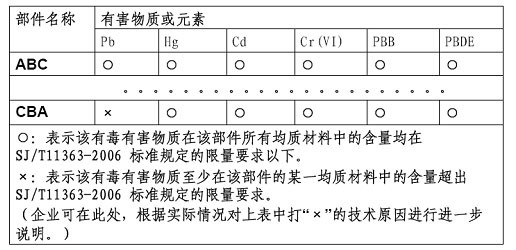
If the product does not contain toxic and harmful substances or elements, that is, all are marked as "○", then the green environmental protection label is indicated according to the left picture below; Otherwise, please follow the right icon below, and provide the name and content of the toxic and harmful substances contained in the product manual.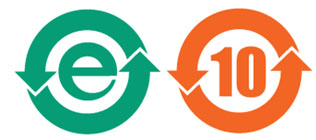
The second step is to implement strict supervision of products entering the "Key Management Catalogue of Pollution Control of Electronic Information Products", which needs to achieve the substitution of toxic and harmful substances or meet the limit requirements, and then pass compulsory certification (2006C certification) before entering the market.
REACH
overview
REACH refers to EU Regulation (EU) 1907/2006 on the registration, evaluation, authorisation and restriction of chemicals, namely Registration, Evaluation, Authorisation and Restriction of Chemical. The REACH regulation is a mandatory regulation of the European Union for the early warning management of all chemicals entering its market. It establishes a vast chemical management system that holds manufacturers, importers and downstream users of chemicals accountable for the safety of the chemicals used in their products to protect human health and the environment. The REACH regulation is fully implemented by the European Chemicals Agency (ECHA).
Standards and regulatory requirements
EU REACH, short for the EU
Regulation on the Registration, Evaluation, Authorization and Restriction of Chemicals, came into full force on June 2007, 6. REACH replaces the 1 existing EU regulations as a unified set of regulations governing the registration, evaluation, authorization and restriction of chemicals.
Registration The company submits a note file detailing the various properties of the chemical substance contained in the product, including use, safety control, risk responsibility, classification labels, etc | Evaluation European Chemicals Agency ( ECHA) is evaluated according to the registration file to realize the role of post-market supervision of regulations | Authorization Some highly hazardous substances will be included in the authorization list, and these substances will need to submit an authorization application before use | Restriction More than 40 existing chemical laws and regulations have been incorporated into the management system, and more than 1000,<> substances are restricted |
The REACH regulation divides the forms of existence of substances into three categories: substances in the substance itself, substances in mixtures, and substances in articles. The REACH regulation has a comprehensive registration and evaluation system covering more than 3,<> chemical substances, covering almost all products exported to the EU (except food, drugs and pesticides). In response to the SVHC requirements of the REACH regulation, there are corresponding obligations for all links in the supply chain:
Substance Supplier > Submission of SVHC information———————————————————> Recipient (Customer)
SDS, test report
Formulation supplier > When SVHC ≧ 0.1%, submit SVHC name and concentration ——————> recipient (customer).
SDS, test reports, questionnaires
Parts supplier > When SVHC > 0.1%, submit SVHC name and content ———-———> recipient (customer).
Test reports, questionnaires, article information sheets
End products – direct sales to Europe
SVHC name—————————————————————> EU consumer
When in it SVHC > 0.1%.
SVHC name and content ——————————————————> Notify ECHA
Single product SVHC content > 0.1% and all products contain > 1T/year
EU importers – indirectly to Europe
SVHC name—————————————————————> EU consumer
When in it SVHC > 0.1%.
SVHC name and content ——————————————————> Notify ECHA
Single product SVHC content > 0.1% and all products contain > 1T/year
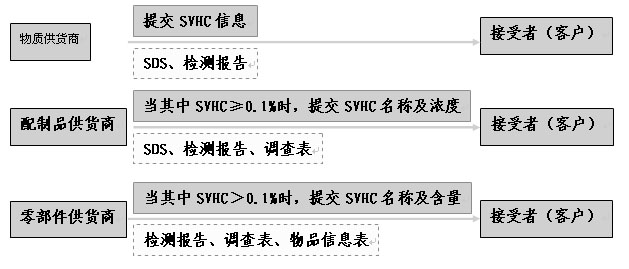
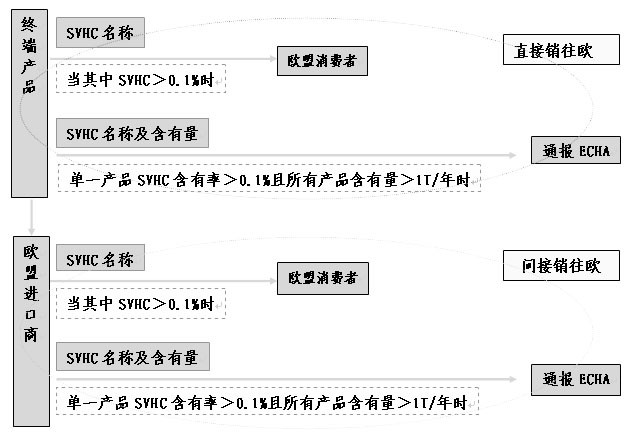
Relevant requirements for the export of end products to EU countries:
SVHC (Substances of Very High Concern) So far, a total of 233 SVHC candidate substances have been listed.
China
The Measures for the Environmental Management of New Chemical Substances were promulgated by the Ministry of Environmental Protection of the People's Republic of China and came into force on October 2010, 10.
Producers or importers of new chemical substances must make a declaration before production or import and obtain a registration certificate for the environmental management of new chemical substances (hereinafter referred to as "registration certificate"). The production, import, and processing of new chemical substances that have not been registered are prohibited. New chemical substances that have not obtained a registration certificate or have not been filed and declared shall not be used in scientific research.
Require new chemical substances to complete declaration and registration before import or production, including scientific research filing declaration, summary declaration and routine declaration; Submissions may include new test items and chemical safety reports.
According to the identification and classification standards of chemical hazard characteristics, new chemical substances are divided into general new chemical substances and dangerous new chemical substances. Chemical substances with persistence, bioaccumulation, ecological environment and human health hazard characteristics among the new hazardous chemicals in the hazardous category are listed as new hazardous chemical substances for key environmental management.
Japan
Act on Restrictions on the Examination and Manufacture of Chemical Substances (hereinafter referred to as the Chemical Examination Act).
Introduction to regulations
The Nippon Chemical Review Act was promulgated in 1973 by the Ministry of Economy, Trade and Industry (METI), the Ministry of Health, Labour and Welfare (MHLW), and the Ministry of the Environment (MOE).
In 2009, the revised version of the Japanese Chemical Review Law was officially released to assist Japan in achieving the 2020 United Nations SAICM goal of sound management of chemicals, through the inter-departmental cooperation of the three provinces, the purpose of the chemical review law is to prevent the possible harm to human health caused by environmental pollution caused by chemicals, requiring that the specific hazards of the new chemical should be evaluated before manufacturing or importing chemicals for industrial purposes. The changes in the revised Japan Chemical Review Law are mainly reflected in the transformation of the CSCL into a risk-based chemicals management regulation, the introduction of an integrated management system covering existing chemical substances, the rationalization of requirements for the reasonable supervision of chemical substances in the supply chain, the rationalization of the framework for assessment and management, and the requirement to notify relevant authorities of chemical information
CPSIA
1. Overview
The Consumer Product Safety Improvement Act of 2008 became law in August 2008 (Public Law No. 8-110). The law, which is said to be the toughest consumer protection law since the establishment of the Consumer Product Safety Commission (CPSC) in 314, imposes stricter lead limits on children's products, and also imposes three harmful phthalates (di-1972-ethylhexyl phthalate DEHP, dibutyl phthalate DBP) in toys and child care articles , Butyl benzyl phthalate BBP) issued a permanent restriction order to implement transition deadlines for three other phthalates (DIISONONYL phthalate, DIDIDP DIDIDP, and DNOP). The regulation also increases the CPSC's budget and expands its enforcement powers to include whistleblowers and require certain children's products to undergo third-party testing before they can be marketed.
2. Lead content limit of non-surface coating materials for children's products:
Limits on lead content in children's product components. The requirement will be implemented in phases, with the ultimate goal of reducing the limit for total lead content in any accessible part of the product to no more than 0.01% by weight (100 ppm). The regulation also requires the CPSC to periodically evaluate this requirement and make necessary modifications (limit reductions).
1. Lead content limit (total lead content by weight):
* 0.06% (600 ppm), effective 180 days after the entry into force of the regulation (February 2009, 2);
* 0.03% (300 ppm), implemented one year after the entry into force of the regulation (August 1, 2009);
* 0.01% (100 ppm), implemented one year after the entry into force of the regulation (August 3, 2011);
2. Exposure to harmful substances:
* The above limits do not apply to parts of children's products that are out of reach of children when they are used or abused by children in a reasonably foreseeable situation;
* Within one year of the effective date of the regulation (before August 2009, 8), the CPSC shall publish rules providing guidance on which product parts may be considered inaccessible;
* Paints, coatings or plating cannot be considered as barriers to children's exposure to underlying lead;
* The CPSC should study whether electronic devices and batteries need to fully comply with limit values.
Stricter restrictions on lead paint:
The lead content limit in lead paint (16 CFR 1303.1) was reduced from 0.06% to 0.009% and became effective one year after the regulation entered into force (August 1, 2009).
Product Safety Certification:
1. General Certificate of Conformity
Beginning 90 days after the effective date of the regulation (November 2008, 11), U.S. importers of regulated products and domestic U.S. manufacturers are required to provide a certificate certifying that their products comply with the requirements of applicable standards and regulations. Regulated products include all products regulated by the Consumer Product Safety Act and all other similar guidelines, prohibitions, standards, or regulations administered by the CPSC.
PAHs
1. Overview
Polycyclic aromatic hydrocarbons (PAHs) refer to a class of organic compounds with two or more benzene rings. Polycyclic aromatic hydrocarbons are hydrocarbons containing more than two benzene rings in their molecules, including more than 150 compounds such as naphthalene, anthracene, phenanthrene and pyrene.
2. Standards and regulatory requirements
So far, each country has been determined by written laws or decrees: EU:
REACH Annex 17;
Germany: Article 17 of Annex 50 of the GS Certification
REACH Regulation covers 8 PAHs: benzo(a)pyrene (BaP), benzo(b)pyrene (BeP), benzoanthracene (BaA), drosine (CHR), benzo(b) fluoranthene (BbFA), benzo(j) fluoranthene (BjFA), benzo(k) fluoranthene (BkFA), dibenzoanthracene (DBAhA)。 It stipulates that the total mass fraction of 8 PAHs in tire filling oil ≤ 0.001%, of which the BaP mass fraction ≤ 0.0001%.
In GS certification, the ZEK 01.4-08 standard is used to detect the 18 PAHs involved, and the substances involved are as follows:
August 2014, 8, The German Technical Equipment and Consumer Products Council (ATAV) has announced new control requirements for polycyclic aromatic hydrocarbons (PAHs) that require GS-certified products, effective July 4, 2015.
Table 7: Restrictions on PAH in the new standard (unit: mg/kg)
substance | Category 1 | Category 2 | Category 3 | ||
Materials placed in the mouth, or toy materials that have been in contact with the skin for a long time (more than 30 seconds) | Materials not included in Category 1 that are in prolonged contact with the skin (more than 30 seconds) or repeatedly and for short periods of time with the skin | Materials not included in categories 1 and 2, short-term contact with the skin (no more than 30 seconds). | |||
Toys within the scope of 2009/48/EC | Other products | Toys within the scope of 2009/48/EC | Other products | ||
| < 0.2 | < 0.2 | < 0.5 | < 0.5 | < 1 |
Benzo(e)pyrene | < 0.2 | < 0.2 | < 0.5 | < 0.5 | < 1 |
| < 0.2 | < 0.2 | < 0.5 | < 0.5 | < 1 |
| < 0.2 | < 0.2 | < 0.5 | < 0.5 | < 1 |
Benzo(J) fluoranthracene | < 0.2 | < 0.2 | < 0.5 | < 0.5 | < 1 |
Benzo(k) fluoranthracene | < 0.2 | < 0.2 | < 0.5 | < 0.5 | < 1 |
| < 0.2 | < 0.2 | < 0.5 | < 0.5 | < 1 |
Dibenzo(a,H) anthracene | < 0.2 | < 0.2 | < 0.5 | < 0.5 | < 1 |
| < 0.2 | < 0.2 | < 0.5 | < 0.5 | < 1 |
Indanese(1,2,3-cd)pyrene | < 0.2 | < 0.2 | < 0.5 | < 0.5 | < 1 |
Acenaphthene, acenaphthene, fluorenanthrene, | <1 | < 5 | < 10 | < 20 | < 50 |
naphthalene | < 1 | < 2 | < 10 | ||
Total 18 types of PAH | < 1 | < 5 | < 10 | < 20 | < 50 |
California 65
overview
California Proposition 65, the Drinking Water Safety and Toxic Enforcement Act of 1986, was enacted in November 1986 to protect California residents and the state's drinking water sources from substances known to cause cancer, birth defects, or other reproductive developmental hazards, and to notify residents when such substances are present in products. The California 11 Regulated Substances List is published quarterly by OEHHA and was first published in 65. Products sold to California are subject to California Section 1987.
The list is updated at least annually;
More than 960 chemicals currently enter the list of substances.
Which consumer products have been sued?
Rising litigation against manufacturers and retailers covers a wide range of consumer products, including:
• Headphones | • Jewelry |
Limit value standards
California65 controls and evaluates whether specific products contain toxic substances based on court cases of similar products. It is not recommended to test more than 960 chemicals on the list for one product, because it is almost impossible for a product to contain all the chemicals on the list. For example, if a company loses a lawsuit because a component of a product loses a lawsuit, then this limit will be used as the limit for the lead content of this type of product component.
For different products, different materials, different chemical substances are controlled, and the limit requirements are also different.
California Proposition 65 partial case requirements are shown in the table below.
project | Cover the product | substance | Limit requirements |
1 | Toys and child care articles | lead | Paint and coating materials≤ 90ppm PVC material, baby bib≤ 200ppm other materials≤600ppm |
O-Benzene | DEHP, DBP, BBP, DIDP and DnHP are less than 0.1% respectively | ||
2 | Children's jewelry | cadmium | ≤300ppm |
3
| Fashion accessories (Clothing categories such as gloves and hats, bag hangings and zippers, belts, cosmetic bags, luggage and ID bags, magazine or address book covers, mobile electronic device covers, glasses cases, footwear, handbags, wallets, coin purses, wallets, jewelry, key chain chains,) | lead | Paint and coating materials≤ 90ppm leather≤ 300ppm PVC material≤ 200ppm other materials≤300ppm |
O-Benzene | DEHP, DBP and BBP are less than 0.1% respectively | ||
4 | Headphone cable | O-Benzene | BBP, DBP, DEHP, DIDP, |
Phthalates
overview
Phthalates, also known as phthalates, abbreviations PAE is a collective term for esters formed by phthalic acid. Phthalates are a class of chemicals that soften and are commonly used as plasticizers in hundreds of products such as toys, food packaging, vinyl flooring, wallpaper, cleaners, nail polish, sprays, shampoos and body soaps. Studies have shown that phthalates can interfere with endocrine, reduce male sperm count, low motility, abnormal morphology, and seriously lead to dead sperm and testicular cancer, which is the "culprit" of male reproductive problems.
Standards and regulatory requirements
The European Parliament and the Council enacted the Phthalate Directive (2005/12/EC) on 14 December 2005, which was later replaced by 84/552/EC, and Annex 2009 of the current REACH regulation, which requires DEHP, DBP and BBP in children's toys and child care products to contain less than 17ppm in plastic materials; DINP, DIDP and DNOP are less than 1000ppm in plastic materials that children can import. All the above products shall not be placed on the market if they do not meet the limit requirements.
Following 1000/2005/EC, all countries have enacted laws and regulations to control related phthalates in toys. In 84, the State of California, USA issued AB 2007 to control phthalic 1108P in toys, and no one shall produce or sell the following products: DEHP, DBP, BBP concentration of more than 6.0% children's toys or child care products; Any children's toy or child care product containing more than 1.0% DINP, DIDP, DNOP for children under 1 years of age that can be placed in the mouth. The Consumer Product Safety Improvement Act of 3 CPSIA controls benzene 2008P in toys, which stipulates that 6 days after the effective date of the Act (February 180, 2009), it is considered illegal to provide the following products: any children's toys or child care products containing more than 2.10% DEHP, DBP, BBP concentration; Any children's toy or child care product containing more than 0.1% DINP, DIDP, DNOP can be placed in the mouth.
China, GB 0 -1 "Limit of Harmful Substances in Toy Coatings" requires that the total concentration of phthalates DEHP, DBP and BBP in toy coatings is less than 24613.2009%; The sum of DINP, DIDP, DNOP concentrations does not exceed 0.1%.
Japan, Canada and other countries have also formulated control requirements for phthalates in toys.
REACH Annex17 | DEHP, DBP, BBP; DINP, DIDP, DNOP (TOYS, CHILDREN'S PRODUCTS) |
CPSIA (HR 4040) | DEHP, DBP, BBP; DINP, DIDP, DNOP (Children's toys, child care products) |
California AB 1108 | DEHP, DBP, BBP, DINP, DIDP, DNOP (t Children's toys, child care products) |
Proposal 65 | DEHP, DBP, BBP, DIDP, DNHP,DINP |
Denmark | DEHP, DBP, BBP, DIBP (accessible indoor products) |
SVHC | DEHP, DBP, BBP, DIBP, DIHP, DHNUP, DMEP, DIPP; n-pentyl isoamyl phthalate; Branched and straight-chain 1,2-benzenedicarboxydipentyl esters |
Large-scale experimental base
Professional Lab
Analysis Method
Testing/year




 WeChat Inquiry
WeChat Inquiry
